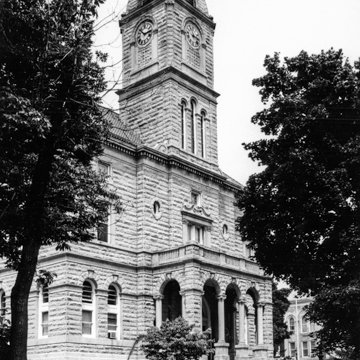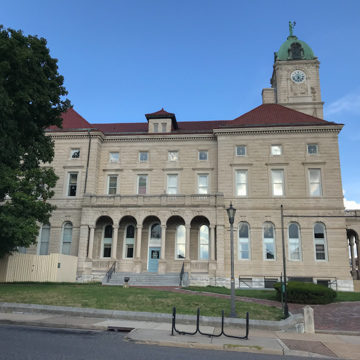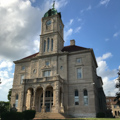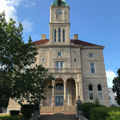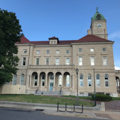After Rockingham County was established in 1778, Thomas and Sarah Harrison deeded two-and-a-half acres to the county for public use. A log courthouse was erected in the center of this large square. The present courthouse, the fifth on this site, demonstrates Collins's mastery of the many popular styles of his time, particularly Romanesque and Renaissance revivals. The buff-colored rough-hewn stone courthouse rises two-and-a-half stories above a raised basement and dominates the downtown. Because of its siting in the center of a square, all four facades are richly embellished. The principal facade has a projecting central pavilion with a three-bay arcaded loggia leading to a centered entrance outlined by sidelights and a tall fanlight. Behind the loggia's stone balustrade, the middle second-story bay projects from the central pavilion and is illuminated by paired windows surmounted by a broken pediment. A two-stage domed clock tower surmounted by a statue of Justice rises from the red tile hipped roof. The courthouse experienced some interior remodeling in the twentieth century, including the elimination of the original second-floor opera house once used for public meetings and entertainment. On the southwest corner of the courthouse square is a 1995 replica of a c. 1900 dome-roofed gazebo that sheltered Big Spring, also known optimistically as Never Failing Spring.
You are here
Rockingham County Courthouse
If SAH Archipedia has been useful to you, please consider supporting it.
SAH Archipedia tells the story of the United States through its buildings, landscapes, and cities. This freely available resource empowers the public with authoritative knowledge that deepens their understanding and appreciation of the built environment. But the Society of Architectural Historians, which created SAH Archipedia with University of Virginia Press, needs your support to maintain the high-caliber research, writing, photography, cartography, editing, design, and programming that make SAH Archipedia a trusted online resource available to all who value the history of place, heritage tourism, and learning.



